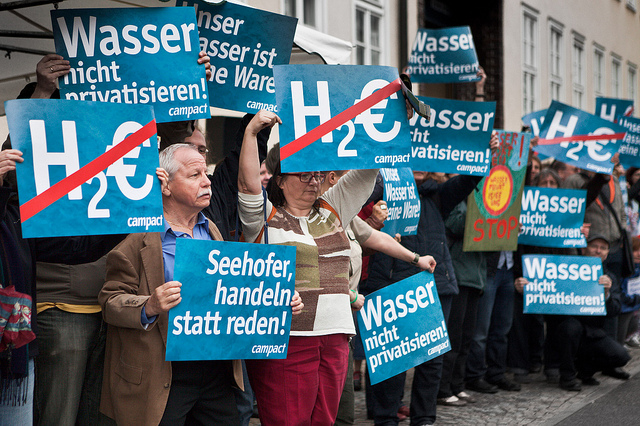Why the European Citizens’ Initiative merits radical reform
On the 1st of April 2014, the European Citizens’ Initiative (ECI) turned two — its unfortunate birthdate determined by EU translation services. Called the first transnational tool of “direct participatory democracy” and “digital democracy” in history, the ECI is a complex procedure by which a million EU citizens ask the European Commission to propose legislation.
In a 2011 Involve briefing paper, I hypothesised two potential impacts of the ECI: an “ideal” scenario where citizens become partners in setting the EU policy agenda and a “disaster” scenario where citizens become pawns of powerful interests. Neither scenario has yet come to pass. EU leaders have not taken ECIs seriously or changed their views of citizens. At the same time, powerful interests have spurned the ECI, finding traditional lobbying much easier than convincing citizens to advance their agendas.
The ECI has instead been adopted primarily by citizens’ groups and national movements with little clout or presence in Brussels. These pioneering ECI campaigns have demonstrated that the ECI has surprising democratic potential for transnational public dialogue and network building. But they’ve also exposed its implementing rules to be fatally flawed and its policy impact frustratingly limited. The ECI shows real promise, but also faces great peril.
The ECI has been used successfully to raise public awareness of and start new transnational discussions on important issues like environmental destruction, unconditional basic income and media pluralism. It has helped build vibrant new transnational networks around topics like street safety and European education. In many ways, it has been more effective at creating European identity and cross-border citizen connections than most EU communications or active citizenship programmes.
Its policy impact, however, has so far been minimal. ECIs that “succeed” are only guaranteed a public hearing in the European Parliament and an official response from the European Commission. But ECI campaigns hope to change policy. The only ECI to complete the full procedure, Right2Water, importantly also the only ECI organised by a well-resourced entity with a strong Brussels presence (the public services union federation EPSU), was rewarded with a vaguely worded communication and no new policy proposals. The second successful ECI, One of Us, organised by national pro-life movements is unlikely to fare much better. Signatures for the only other ECI to reach the one million signature mark, Stop Vivisection, are still being verified. All but two of the other 23 ECIs launched have collected fewer than 100,000 signatures, many under 10,000.
Some EU observers claim that the Commission’s weak response to Right2Water means the ECI is dead. “With no hope of policy impact, who would use the ECI?” they say. As a tool for direct democracy, the ECI has indeed been a failure. As a tool for participatory and digital democracy, there is still a glimmer of hope. However, as a tool for public dialogue and network building, the ECI has been a surprising success.
The real threat to the ECI is its implementing rules. They are completely mismatched to the ECI’s true nature. They impose requirements comparable to a robust direct democracy tool on a procedure whose legal impact is closer to a petition. Current rules require an ECI’s supporters to share sensitive personal data and use needlessly bureaucratic procedures. They effectively condemn campaigns to use an online signature collection system that’s riddled with glitches and prohibit effective online campaigning. They don’t give campaigns enough time, provide little assistance and expose organisers to legal liability. Importantly, they restrict ECI subjects to those the Commission deems within its legal competence. So far, 40% of proposed ECIs, including on hot topics like nuclear power and EU governance, have been refused registration.
The ECI cannot survive in its current form. But it has shown too much promise to simply abandon. Its implementing rules must be radically simplified to match its true impact.
Many EU citizens seem increasingly desperate to have a say in Europe. Some may seek destructive actions if constructive ones aren’t available. In 2013, the largest number of citizens in EU history petitioned the European Parliament. At the same time, more citizens plan to vote for anti-EU parties in the upcoming European elections than ever before. There’s no time to waste.
As part of the Treaty on European Union (article 11.4), the ECI is the only legal toehold EU citizens have in influencing the EU policy agenda. In 2015, the European Parliament and Council will review the ECI’s implementing regulation and related rules. In preparation,The ECI Campaign collected learning from the first two years of the ECI in a workshop and companion publication, An ECI That Works!, to be published on the 15th of April 2014. The experiences of 16 ECI campaigns are complemented by analyses from officials, politicians and researchers. Together they paint a picture of an ECI with tremendous promise that is in peril due to ridiculously burdensome rules. They also recommend specific reforms that will help the ECI to survive and fulfil its promise of a more democratic future for Europe.
Janice Thomson, public engagement specialist and citizen participation researcher, is co-editor of An ECI That Works!. She was Involve’s EU Public Engagement Advisor and The ECI Campaign’s representative in Brussels in 2010-2011. She currently resides in Chicago, USA.
This article was also published on www.involve.org.uk and www.europeancitizensabroad.eu.
Article Photo: Unconditional Basic Income ECI campaign from www.basicincome2013.eu
Slider Photo: Right2Water ECI from Green European Journal
